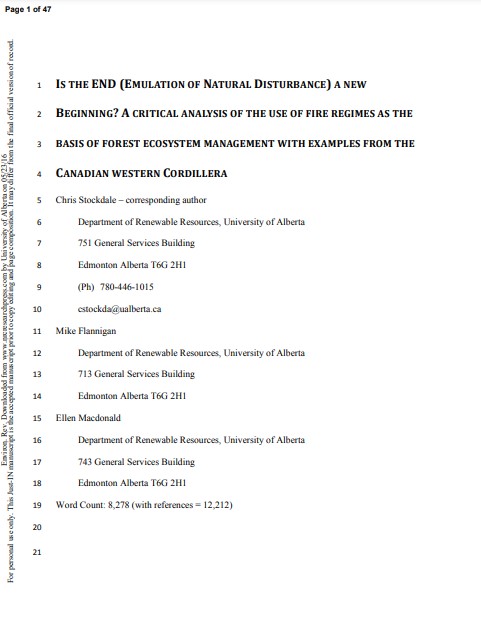Is the END (emulation of natural disturbance) a new beginning? A critical analysis of the use of fire regimes as the basis of forest ecosystem management with examples from the Canadian western Cordillera.
Bosque Modelo:
Foothills
Temática:
Gestión forestal
Tipo de documento:
Artículo científico
Resumen
As our view of disturbances such as wildfire has shifted from prevention to recognizing their ecological necessity, so too forest management has evolved from timber-focused even-aged management to more holistic paradigms like ecosystem-based management. Emulation of natural disturbance (END) is a variant of ecosystem management that recognizes the importance of disturbance for maintaining ecological integrity. For END to be a successful model for forest management we need to describe disturbance regimes and implement management actions that emulate them, in turn achieving our objectives for forest structure and function. We review the different components of fire regimes (cause, frequency, extent, timing, and magnitude), we describe low-, mixed-, and high-severity fire regimes, and we discuss key issues related to describing these regimes. When characterizing fire regimes, different methods and spatial and temporal extents result in wide variation of estimates for different fire regime components. Comparing studies is difficult as few measure the same components; some methods are based on the assumption of a high-severity fire regime and are not suited to detecting mixed- or low-severity regimes, which are critical to END management, as this would affect retention in harvested areas. We outline some difficulties with using fire regimes as coarse filters for forest management, including (i) not fully understanding the interactions between fire and other disturbance agents, (ii) assuming that fire is strictly an exogenous disturbance agent that exerts top-down control of forest structure while ignoring numerous endogenous and bottom-up feedbacks on fire effects, and (iii) assuming by only replicating natural disturbance patterns we preserve ecological processes and vital ecosystem components. Even with a good understanding of a fire regime, we would still be challenged with choosing the temporal and spatial scope for the disturbance regime we are trying to emulate. We cannot yet define forest conditions that will arise from variations in disturbance regime; this then limits our ability to implement management actions that will achieve those conditions. We end by highlighting some important knowledge gaps about fire regimes and how the END model could be strengthened to achieve a more sustainable form of forest management.
Información Bibliográfica
Autor:
Stockdale, C., Flannigan, M., & Macdonald, E.
Revista:
Stockdale, C., Flannigan, M., & Macdonald, E.
Año:
2016
N°:
-
País :
Canadá
Páginas:
233 - 243
Volumen:
24
Idioma:
Ingles
Palabras claves
Fire regime; emulation of natural disturbance; sustainable forest management; fire severity; ecosystem management





